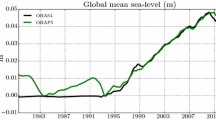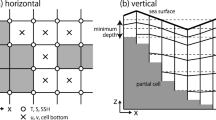Abstract
The performance of a z-level ocean model, the Modular Ocean Model Version 4 (MOM4), is evaluated in terms of simulating the global tide with different horizontal resolutions commonly used by climate models. The performance using various sets of model topography is evaluated. The results show that the optimum filter radius can improve the simulated co-tidal phase and that better topography quality can lead to smaller rootmean square (RMS) error in simulated tides. Sensitivity experiments are conducted to test the impact of spatial resolutions. It is shown that the model results are sensitive to horizontal resolutions. The calculated absolute mean errors of the co-tidal phase show that simulations with horizontal resolutions of 0.5° and 0.25° have about 35.5% higher performance compared that with 1° model resolution. An internal tide drag parameterization is adopted to reduce large system errors in the tidal amplitude. The RMS error of the best tuned 0.25° model compared with the satellite-altimetry-constrained model TPXO7.2 is 8.5 cm for M2. The tidal energy fluxes of M2 and K1 are calculated and their patterns are in good agreement with those from the TPXO7.2. The correlation coefficients of the tidal energy fluxes can be used as an important index to evaluate a model skill.
Similar content being viewed by others
References
Accad Y, Pekeris C L. 1978. Solution of the Tidal Equations for the M2 and S2 Tides in the World Oceans from a Knowledge of the Tidal Potential Alone. Philosophical Transactions of the Royal Society of London. Series A, Mathematical and Physical Sciences, 290(1368): 235–266
Adcroft A, Hill C, Marshall J. 1997. Representation of topography by shaved cells in a height coordinate ocean model. Mon Weather Rev, 125(9): 2293–2315
Antonov J, Seidov D, Boyer T, et al. 2010. World Ocean Atlas 2009, Volume 2: Salinity. S. Levitus, Ed. NOAA Atlas NESDIS, 69
Arbic B K, Garner S T, Hallberg R W, et al. 2004. The accuracy of surface elevations in forward global barotropic and baroclinic tide models. Deep Sea Res Pt II, 51(25): 3069–3101
Arbic B K, Wallcraft A J, Metzger E J. 2010. Concurrent simulation of the eddying general circulation and tides in a global ocean model. Ocean Modelling, 32(3): 175–187
Bell T. 1975. Topographically generated internal waves in the open ocean. J Geophys Res, 80(3): 320–327
Eanes R, Bettadpur S. 1995. The CSR 3.0 global ocean tide model. Center for Space Research, Technical Memorandum, CSR-TM-95-06
Egbert G D, Erofeeva S Y. 2002. Efficient inverse modeling of barotropic ocean tides. J Atmos Ocean Tech, 19(2): 183–204
Egbert G D, Ray R D. 2000. Significant dissipation of tidal energy in the deep ocean inferred from satellite altimeter data. Nature, 405(6788): 775–778
Egbert G D, Ray R D, Bills B G. 2004. Numerical modeling of the global semidiurnal tide in the present day and in the last glacial maximum. J Geophys Res, 109(C3): C03003
Fretwell P, Pritchard H D, Vaughan D G, et al. 2013. Bedmap2: improved ice bed, surface and thickness data sets for Antarctica. Cryosphere, 7(1): 375–393
Griffies S M, Harrison M J, Pacanowski R C, et al. 2004. A technical guide to MOM4. GFDL Ocean Group Tech Rep, 5: 371
IOC, IHO, BODC. 2003. Centenary Edition of the GEBCO Digital Atlas, published on CD-ROM on behalf of the Intergovernmental Oceanographic Commission and the International Hydrographic Organization as part of the General Bathymetric Chart of the Oceans, Liverpool, UK: British Oceanographic Data Centre
Jayne S R, St Laurent L C. 2001. Parameterizing tidal dissipation over rough topography. Geophys Res Lett, 28(5): 811–814
Large W G, Mc Williams J C, Doney S C. 1994. Oceanic vertical mixing: A review and a model with a nonlocal boundary layer parameterization. Rev Geophys, 32(4): 363–403
Le Provost C. 2001. Ocean tides. International Geophysics, 69: 267–303
Locarnini R, Mishonov A, Antonov J, et al. 2010. World Ocean Atlas 2009, vol. 1, Temperature, edited by S. Levitus. Washington, DC: US Gov Print Off, 184
Müller M, Haak H, Jungclaus J, et al. 2010. The effect of ocean tides on a climate model simulation. Ocean Modelling, 35(4): 304–313
Munk W, Wunsch C. 1998. Abyssal recipes: energetics of tidal and wind mixing. Deep-Sea Research Part II, 45(12): 1977–2010
Murray R J. 1996. Explicit generation of orthogonal grids for ocean models. J Comput Phys, 126(2): 251–273
NGDC. 1988. Data Announcement 88-MGG-02, Digital relief of the Surface of the Earth.. edited. Boulder, Colorado: NOAA, National Geophysical Data Center
NGDC. 2006. 2-minute Gridded Global Relief Data (ETOPO2v2), edited by U.S. Department of Commerce N. O. a. A. A.. Boulder, Colorado: National Geophysical Data Center
Pacanowski R C, Gnanadesikan A. 1998. Transient response in a zlevel ocean model that resolves topography with partial cells. Mon Weather Rev, 126(12): 3248–3270
Pawlowicz R, Beardsley B, Lentz S. 2002. Classical tidal harmonic analysis including error estimates in MATLAB using T_TIDE. Comput Geosci-UK, 28(8): 929–937
Pekeris C L, Accad Y. 1969. Solution of Laplace's Equations for the M2 Tide in the World Oceans. Philosophical Transactions of the Royal Society of London.
Series A, Mathematical and Physical Sciences, 265(1165): 413–436
Schiller A, Fiedler R. 2007. Explicit tidal forcing in an ocean general circulation model. Geophys Res Lett, 34(3): L03611
Schwiderski E W. 1980. On charting global ocean tides. Rev Geophys, 18(1): 243–268
Shriver J, Arbic B K, Richman J, et al. 2012. An evaluation of the barotropic and internal tides in a high-resolution global ocean circulation model. J Geophys Res, 117(C10): C10024
Shum C, Woodworth P, Andersen O, et al. 1997. Accuracy assessment of recent ocean tide models. J Geophys Res, 102(C11): 25173–25194
Simmons H L, Hallberg R W, Arbic B K. 2004. Internal wave generation in a global baroclinic tide model. Deep Sea Res Pt ?, 51(25): 3043–3068
Smith W H, Sandwell D T. 1997. Global sea floor topography from satellite altimetry and ship depth soundings. Science, 277(5334): 1956–1962
Yu H, Wang Z, Kuang L, et al. 2015. A numerical study on the circulation and tide in a zigzag bay. Acta Oceanologica Sinica, 34(1): 119–128
Wunsch C. 1975. Internal tides in the ocean. Rev Geophys, 13(1): 167–182
Wang Yihang, Fang Guohong, Wei Zexun, et al. 2010. Accuracy assessment of global ocean tide models base on satellite altimetry (in Chinese). Adv Earth Sci, 25(4): 353–359
Author information
Authors and Affiliations
Corresponding author
Additional information
Foundation item: The National Natural Science Foundation of China (NSFC)—Shandong Joint Fund for Marine Science Research Centers under contract No. U1406404; the National Basic Research Program (973 Program) of China under contract No. 2010CB950300; the Project of Comprehensive Evaluation of Polar Areas on Global and Regional Climate Changes under contract No. CHINARE04-04; the National Natural Science Foundation of China under contract No. 41406027.
Rights and permissions
About this article
Cite this article
Xiao, B., Qiao, F. & Shu, Q. The performance of a z-level ocean model in modeling the global tide. Acta Oceanol. Sin. 35, 35–43 (2016). https://doi.org/10.1007/s13131-016-0884-z
Received:
Accepted:
Published:
Issue Date:
DOI: https://doi.org/10.1007/s13131-016-0884-z




